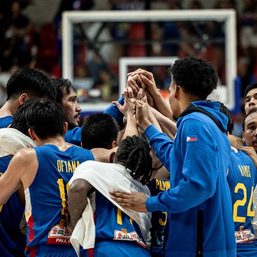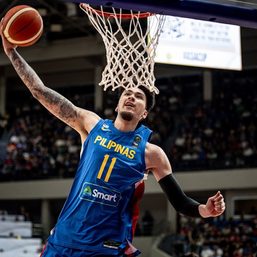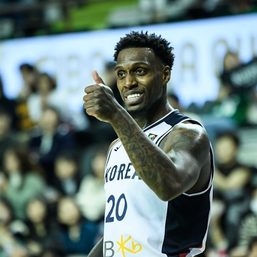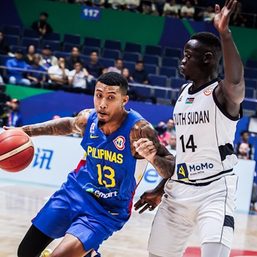SUMMARY
This is AI generated summarization, which may have errors. For context, always refer to the full article.

MANILA, Philippines – Such a huge difference a change in coach, system, and culture makes.
Standing faithfully by Gilas Pilipinas during a particularly frustrating two-year stretch that saw more losses than triumphs, Filipino fans have yearned for a national team they could rally behind in earnest.
They were given a taste of it when Gilas ended six decades of futility in the Asian Games by bringing home the gold last year. Fans were served more than their just desserts in the February FIBA Asia Cup qualifying window when Gilas won both their games by an average margin of 41.5 points.
The common denominator? The legendary coach Tim Cone.
Of course, there are still naysayers who point out that Hong Kong is not exactly an elite Asian team and Chinese Taipei was without a naturalized player, never mind that they kept the scoreline close against New Zealand in their previous game. All valid observations.
But these can be negated by the fact that this latest iteration of Gilas has had roughly a week to prepare and is still at the getting-to-know-you and the system stage. But the way they have adapted to the system that Cone has slowly instilled should give even the most stone-cold skeptics hope that the team just might turn out to be special.
There have also been those who have asserted that it is immaterial to compare the Cone-mentored squad to its World Cup predecessor, that it is high time to already move on and desist from bringing up the ghosts of Gilas past.
But the past serves as the baseline from which the present can be built on.
There are valuable lessons that can be learned and unwarranted drama that can be discarded if history is not relegated to irrelevance.
And so we look back at and take stock of how far the team has gone since the FIBA World Cup to help us understand how far the team can still go in its goal to make the Olympics, if not this year in Paris then in 2028 in Los Angeles.
Unlocking full potential
One standout characteristic of Gilas Pilipinas under Cone is that there is a certain fluidity in the movement of the players that allows the game to flow more smoothly. The players know where they need to be and where the ball has to be. It was true in the Asian Games. It remains true in the FIBA Asia Cup qualifiers.
During the FIBA World Cup, Jordan Clarkson was allowed by the coaching staff to dominate the ball, attempting at least 21 shots per game. There were instances when everyone else around him appeared to just wait to see what he would do and if his shots would go in.
Kai Sotto had less than four shot attempts per outing. Clarkson ended up with an impressive average of 26 points in five games. The only other player to average in double figures was Dwight Ramos with 13.2 points.
Justin Browlee led Gilas in scoring with 21 points in each of the two games in the FIBA Asia Cup qualifiers. But he got plenty of help. Four others also normed double figures.
Sotto was finally given his due touches and delivered with 15.5 points per game. Ramos contributed 10.5 points. Kevin Quiambao, despite being the only collegiate player in the roster, showed he could play with the big boys by pumping in 12.5 points per showing. Calvin Oftana almost joined the double digit club with nine points per game.
The wide distribution of wealth can be attributed to a number of factors.
Cone made it part of the design to allow Sotto the space to establish his presence in the low block, something that was missing from the World Cup where the bigs were not made integral components of the offense and none of them took more than five attempts per game.
Finally given the blessing of a coach who believed in him, the “Kaiju” was unleashed and produced the numbers – 12.5 rebounds, 2.5 blocks, and 3 assists.
Sotto asserting himself against the Hong Kong and Chinese Taipei frontliners led to good things – the floor opened up for incursions to the basket, with Sotto as the willing passer, and the outside was freed up for the Gilas gunners, resulting in a respectable 39% shooting clip from three.
Better ball movement
The triangle became the framework from which ball movement emanated and became one of the main weapons of Gilas Pilipinas. Rarely was there any display of hero ball or one-on-one isolation where one player dribbled the shot clock away while the rest of the team remained frozen from action.
In its place were the wings driving to test the opposing team’s defense then kicking out to the open shooter or the high post getting the ball to move it around until the open man was found.
This was evidenced by the team dishing out an impressive 31.5 assists in the qualifiers. Scottie Thompson led the way for Gilas with nine assists per game. During the World Cup, Gilas only averaged 16 assists per game.
Cone clearly defined his expectation from each player. Chris Newsome, a prolific scorer with Meralco Bolts, accepted his task as the primary defensive stopper for Gilas.
Chinese Taipei star Cheng Liu sizzled in their previous game against New Zealand where he scored 20 points on 8/16 shooting. After sinking two early threes against Gilas, Liu ended up making a total of just five shots from 14 attempts, largely because of the relentless pressure from Newsome.
Carl Tamayo dropped 11 points and hauled down six boards against Chinese Taipei. Tamayo provides Gilas with a versatile big man, Cone’s own version of Ranidel de Ocampo, who is also the team’s tough guy and enforcer.
Tamayo and Quiambao were the “Bruise Brothers” of the NU Bullpups when the two were in high school. It is not far-fetched that they will relive this role in Gilas uniforms.
Bigger tests ahead
All these positives still beg the question: Can Gilas Pilipinas look just as good when they face bigger teams like New Zealand in the next window and world caliber squads in the Paris Olympic qualifiers?
Cone will be the first to admit that there is still so much work to be done. He has always been known to keep himself grounded even as his sights are always lasered towards the bigger target.
One thing going for Cone is that he is also fully aware that the team holds so much promise.
Brownlee has not fully shaken off the rust from his forced layoff. Sotto has had four straight double-doubles (two in the Japan B. League, two in the FIBA Asia Cup qualifiers) and is slowly beginning to understand what it takes to be a dominant big man.
AJ Edu and June Mar Fajardo have yet to join the team. The entire squad still has to learn to play together and for each other. Cone knows they eventually will.
Gilas Pilipinas can still get better. It will become better. – Rappler.com
Add a comment
How does this make you feel?




There are no comments yet. Add your comment to start the conversation.